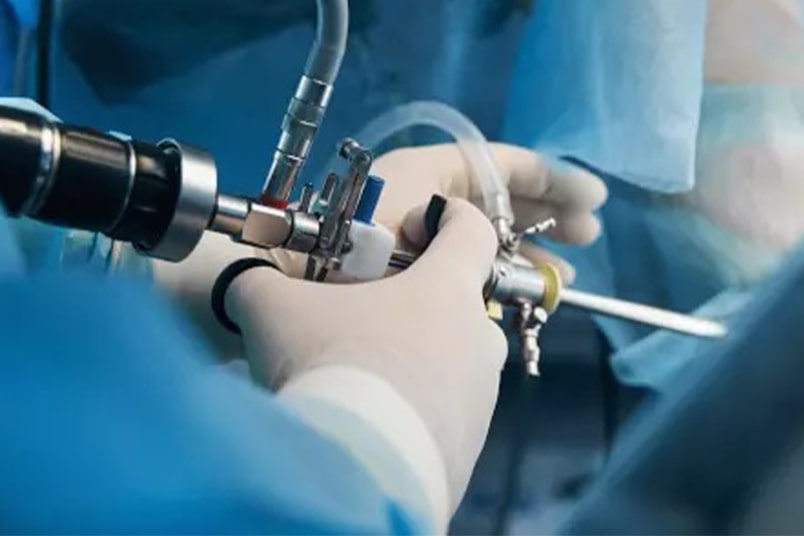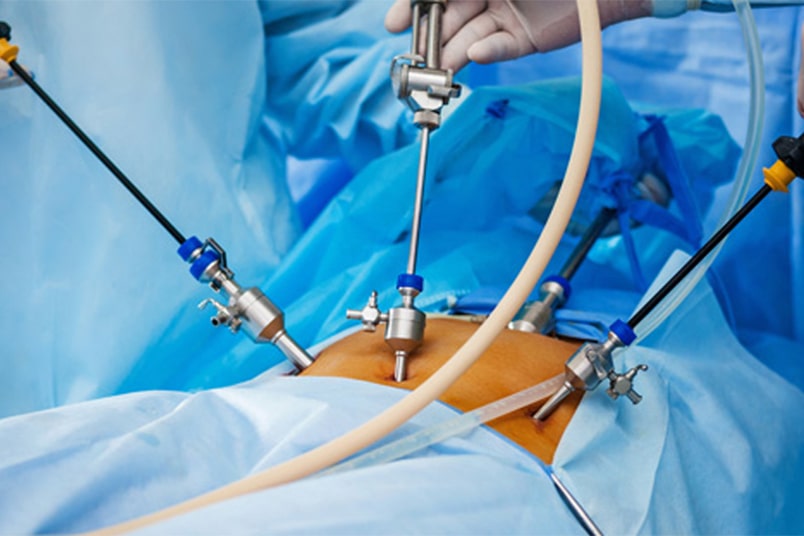Over 20% of people in their reproductive years may be facing infertility, but thanks to a range of fertility treatments, many have found hope in becoming parents. Laparoscopic surgery is a remarkable option among the various techniques available, offering a ray of hope for those struggling with fertility conditions and blocked fallopian tubes.
Laparoscopy surgery for infertility
Laparoscopy is a modern and highly effective technique that has largely replaced traditional surgeries for infertility. Instead of large incisions, this procedure only requires small incisions made under the navel region.
Through these tiny openings, a camera and specialized instruments are inserted to diagnose and treat infertility. That’s why it’s often referred to as “keyhole surgery.”
Laparoscopy is a type of surgery that is less invasive and helps doctors examine the pelvic region, including the ovaries, fallopian tubes, uterus, and cervix. It is an effective way to detect and treat conditions such as endometriosis, uterine fibroids, abnormal fallopian tubes and pelvic adhesions.
The laparoscope, a special instrument with a camera and a flexible tube, allows doctors to see inside the body and view real-time images on a monitor.
Before performing a laparoscopy, various tests are conducted including blood analysis, urinalysis, electrocardiogram (ECG), X-ray, CT Scans, and MRI Scans. These tests help in assessing the condition and determining the appropriate course of action.
The procedure of laparoscopy surgery

Laparoscopy is a common procedure used to investigate and treat infertility. It is usually done on a day care basis, meaning patients can go home the same day. During the procedure, anaesthesia will be given to ensure comfort. Here’s a brief description of how laparoscopy works.
- General anaesthesia is commonly used to induce sleep during the procedure
- Pain is not felt during the procedure.
- Incisions of approximately 0.5-1cm in length are made below the navel.
- A cannula, a small flexible tube, is inserted to inflate the abdominal region with carbon dioxide gas.
- The laparoscope is then inserted through the incision, capturing real-time images on a screen.
- The necessary instruments are inserted during the procedure, and either an infertility diagnosis or laparoscopy infertility treatment is carried out.
- Once the procedure is completed, the cannula, laparoscope, and other instruments are taken out, and the incisions are closed using surgical tape or stitches.
- Following the surgery, the patient’s breathing rates and heartbeats are closely monitored, along with observing any adverse reactions to anaesthesia.
- After a few hours, when the effects of anaesthesia wear off and all the vital signs are normal, the patient will be discharged. Throughout the process, utmost care is taken to ensure the patient’s safety and well-being.
Infertility diagnostic laparoscopy requires a few incisions and is solely used to identify the root cause of infertility. On the other hand, operative laparoscopy involves additional incisions and is performed to treat, correct, or repair the underlying cause of infertility.
Who would be an ideal candidate for this surgery?
Women who have elevated risk factors, abnormal ultrasound scan or HSG (hysterosalpingogram) findings, or have been struggling with infertility for a long time may require laparoscopic assessment and/or treatment. There are several conditions that suggest the need for laparoscopy, such as:
- Hysterosalpingography is an X-ray technique used to identify any blockages in the fallopian tubes. Laparoscopy can effectively remove blockages in the fallopian tubes, increasing the success rates of fertility treatments.
- Laparoscopy is an effective solution for addressing endometriosis, a condition that can cause fertility issues, abnormal menstruation, and pelvic pain.
- In case of PCOS, laparoscopic ovarian drilling can be a suitable treatment to promote regular ovulation.
- Laparoscopic procedures can be performed to repair a distorted uterus, remove fibroids, or correct pelvic adhesions, improving fertility prospects.
- It is important to consult your doctor regarding the removal of large endometriotic cysts, as it may impact ovarian reserves. Your doctor can provide guidance on available options.
What to Expect from Laparoscopy Surgery?
Laparoscopy is a highly effective method for both diagnosing and treating infertility issues. This procedure is performed under anaesthesia, and as the effects of the anaesthesia wear off, it is common to experience a mild sore throat.
Post laparoscopy, patients may also experience pain, discomfort near the incision site, and abdominal bloating due to the use of carbon dioxide. However, these symptoms typically subside within a few days after the surgery.
In some cases, patients may also experience pain near the shoulders, which usually resolves within one to two days. To manage any pain symptoms, healthcare providers may prescribe pain medications and antibiotics, and it is important for patients to rest for a couple of days.
Additionally, proper care of the wounds, including cleaning and dressing, is crucial to prevent secondary infections.
Risks of laparoscopy
Laparoscopy for infertility, like any surgical procedure, carries some risks. However, it is important to note that only a small percentage of patients, around 1-2 percent, experience complications during or after the procedure.
These complications may include anaesthesia-related problems. In some cases, minor issues such as infection or skin irritation at the incision site may occur.
Other potential complications that may arise include the development of adhesions and hematomas, which are swellings caused by damage to a blood vessel. Additionally, there is a possibility of experiencing an allergic reaction, nerve damage, or the formation of blood clots.
Sometimes, an instrument or laparoscopy can accidentally cause harm to an organ in the abdomen or pelvis, like the bowel or bladder. Although this can happen to anyone, it is more likely to occur in women who have had previous abdominal surgery, pelvic adhesions, or who are overweight.
If an injury does occur, a larger incision would be necessary to fix the damaged organ, and the patient would need to stay in the hospital for recovery.
Laparoscopy has been proven to be beneficial for both diagnosing and treating various fertility conditions. The main objective of this procedure is to assess the internal pelvic condition, address any issues, and minimize the need for large incisions. Following a laparoscopy for infertility, individuals can anticipate a speedy recovery, reduced discomfort, and increased likelihood of conceiving.
NU Fertility, Bangalore, offers state-of-the-art infertility treatment options. Their team of healthcare professionals is committed to delivering exceptional care with utmost precision and expertise in the field of reproductive health. If you require specialized assistance for conditions like blocked fallopian tubes or infertility, contact NU Fertility.
References:
- LAPAROSCOPY FOR INFERTILITY. HEALTH UNIVERSITY OF UTAH. https://healthcare.utah.edu/fertility/treatments/surgery/laparoscopy.
- Fertility Surgery. Weill Cornell Medicine. https://ivf.org/treatments-and-services/fertility-surgery.
- Fallopian Tube Procedures for Infertility. KAISER PERMANENTE. https://healthy.kaiserpermanente.org/health-wellness/health-encyclopedia/he.fallopian-tube-procedures-for-infertility.hw203637.
- Arab W. (2022). Diagnostic laparoscopy for unexplained subfertility: a comprehensive review. JBRA assisted reproduction, 26(1), 145–152. https://www.ncbi.nlm.nih.gov/pmc/articles/PMC8769170/.
Author: Dr. Sneha J



